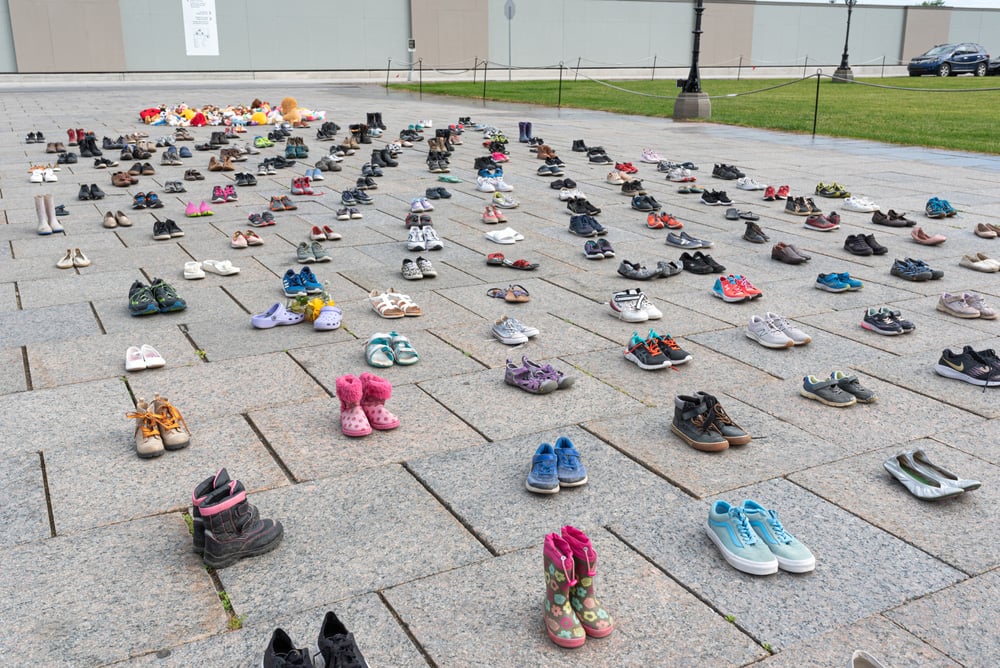In the weeks since the Tk’emlúps te Secwépemc First Nation announced it had found the remains of 215 children at what was once Canada’s largest residential school in Kamloops, an opportunity to reconcile a painful past, a troubling present and a hopeful future might be emerging.
The Truth and Reconciliation Commission had previously confirmed 51 deaths at the Kamloops Indian Residential School, but the Tk’emlúps te Secwépemc community had long believed there were many more former students buried in unmarked graves.
The discovery of 215 children’s remains using ground-penetrating radar confirmed the horrific truth, and the ensuing grief among Indigenous peoples was public and palpable.
In addition to the shock and outrage, and in spite of this deep sorrow, First Nations have courageously responded with compassion and solidarity. Since the grim revelation on May 27, people have travelled from hundreds of kilometres away to Kamloops to support one another and pay homage to the lost children. Honour songs have been sung, prayers said, burnings and smudges offered, tears shed and community connections reaffirmed.
For non-Indigenous people, something — finally — seems to be shifting as well.
To a degree that surpasses the public response to the TRC’s work, which wrapped up in December 2015, and the final report of the National Inquiry into Missing and Murdered Indigenous Women and Girls, which was presented to the public in June 2019, the story of the 215 children is galvanizing settler society in support of Indigenous peoples as never before.
Memorials featuring 215 sets of little shoes, candlelight multi-faith prayer gatherings, drumming circles, outpourings of emotion, purchases of orange T-shirts and calls for action are taking place around the world.
We now have the opportunity to turn this momentum into transformative action that goes beyond acknowledging these schools were cruel institutions for children removed from the love of their families and subjected to horrific abuse that in any age we would define as criminal. We must recognize that residential schools were designed to contribute to the overarching strategy of alienating Indigenous peoples from their lands and their systems of self-governance.
The 215 children in Kamloops — and the more than 4,100 children who died in residential schools across the country, as identified by the TRC’s Missing Children project — represent not only the tragedy of kinship loss, but the weight of an economic and political system of colonialism that continues to cause harm to this day.
Under Canadian colonialism, Indigenous peoples were “a problem,” because they obstructed settler access to lands and resources. Under British/Canadian law, Indigenous peoples held title and rights to the land. Residential schools became central to settler society’s solution to the “Indian problem” as, in theory, the schools would transform Indigenous rights holders into assimilated ethnic minorities.
As this process unfolded and Indigenous peoples were isolated onto reserves, and their ability to manage and control resources were severely curtailed, they came to be stigmatized as a culture defined by social ills: unemployment, poverty, addiction, etc. The circle of colonialism was complete, with the effects of abusive settler policies serving to justify the continued subjugation of Indigenous lands and people.
Acts of resistance
It didn’t have to be this way. In the past, Indigenous peoples, along with a few settler allies, did their best to promote alternatives to residential schools, as well as less-colonial ways for settlers and Indigenous peoples to interact.
When B.C. was still a colony of Britain and before Canada’s founding, some Coast Salish leaders decided it would be useful for their children to obtain a western-style education. They wanted to better understand (and resist) the settlers’ efforts to control their land and resources. Most importantly, they sought to create equitable and respectful relationships with the newcomers to their territories — newcomers they recognized were there to stay.
In the early 1860s, for example, Chief Alexis of Xwchíyò:m (near Chilliwack) sent one of his daughters to St. Mary’s residential school in Mission, B.C. Two years later, she established a school in her home community where she was the teacher.
As far as I know, this was the first Indigenous-run and operated school in B.C. But the government never supported or funded that school. In fact, it worked to undermine the Xwchíyò:m school when a few years later, government coffers began channeling funding exclusively to residential schools.
A little more than a decade later, in 1879, both the Nlaka’pamux and Stó:lō leadership along the lower Fraser and Thompson River systems proposed forms of self-governance that included self-funded and/or co-funded day schools. The Chiefs were clear that these schools would be designed to teach their children a western curriculum, but they would also operate on the principle of Indigenous control of Indigenous education. They would supplement studies with traditional land-based learning and activities, and they would allow students to return home each evening. Of course, the federal government rejected these proposals.
By the 1920s, under the Indian Act, Canadian police were empowered to enforce residential school attendance on Indigenous families who resisted the system. But even then, other options were available and some boldly followed them. In this era a few Indigenous communities established day schools, and in the face of bold requests from Indigenous mothers, a few compassionate teachers and administrators in the provincial system created ways to admit a small number of Indigenous children despite a lack of federal financial support.
Abuse not limited to residential schools
In terms of being on the frontlines of settler colonialism, Indigenous children have always been, and continue to be, the most vulnerable.
In the 1790s, would-be Spanish colonists took Nuu-chah-nulth and Coast Salish children to Mexico and placed them in a residential school in Acapulco. Their fates remain unknown.
In 1858, during the Fraser River Gold Rush, American miners kidnapped many Stó:lō and Nlaka’pamux boys and brought them to California, where they were exploited for free labour. Miraculously, at least two of them found their way home 30 years later.
In 1884, a 14-year-old Stó:lō boy named Louie Sam from the Sema:th (Sumas) community near Abbotsford was framed and arrested for a crime he did not commit and then lynched by a mob of Americans — with complicit assistance from Canadians — on Canadian soil. Justice was never served, and Stó:lō people lived in fear of settler violence when travelling off of their reserves.
In more recent times, what is known as the '60s Scoop saw social workers sweep in and apprehend Indigenous youth deemed “at risk,” placing them in non-Indigenous foster and adoptive homes. Many argue the modern-day child welfare system perpetuates these damaging practices.
And the tragic legacy of missing and murdered Indigenous women, girls and two-spirit people is not limited to the past 40 or 50 years. Indigenous females were the victims of atrocious crimes perpetrated by the earliest miners and some pioneer settlers, and they continue to be preyed upon to this day.
Many methods of oppression
While Indigenous youth were being housed in residential schools in Canada — in operation between the 1860s and 1990s — the parents of Indigenous children were having their land rights denied, their economic opportunities curtailed, and their political voices eclipsed.
By the mid-19th century in B.C., then-governor James Douglas (1858-1864) — together with Indigenous peoples — had created large Indian reserves in the Fraser Valley and in parts of the B.C. Interior that were designed to accommodate First Nations’ anticipated future commercial agricultural and ranching needs. Some lands in the Fraser canyon were additionally set aside to specifically enable and protect Indigenous people’s ability to participate in commercial mining activities.
However, three years after Douglas’s retirement, his successors reduced the reserves by more than 90 per cent — without Indigenous consent. The reductions were justified in part with the argument that Indigenous peoples were traditionally fishers, not farmers, ranchers or miners, and therefore would do just fine in the emerging colonial society without large land bases — as long as they had their fishery.
Then, in 1886, the government passed legislation making it illegal for Indigenous peoples to sell fish caught in non-tidal waters. The vast majority of First Nations suddenly found themselves with no way to engage in the emerging economy while simultaneously being denied the ability to continue their traditional economy. Hunting and gathering rights were similarly restricted through non-consultative provincial legislation.
Also in 1886, the federal government passed a law making Indigenous self-governance (the potlatch) and spirituality (the Tamanawas winter dance) illegal. Poverty, powerlessness and despair became normalized.
Denied their own governance, Indigenous peoples were also barred from the political system the settlers had established for themselves. First Nations did not secure the right to participate in Canadian democracy until 1960, by which time they were a small minority which could no longer easily influence settler politics.
Genuine reconciliation key to a better future
This is the larger history of which residential school abuse and intergenerational trauma are an integral part. It is an important context to consider with regard to the 215 children’s remains in unmarked graves at the former Kamloops residential school.
This is also why reconciliation is not yet complete, and why it is so urgent that all people of goodwill come together to help contribute to the building of genuine reconciliation.
The building process will be complicated. It will necessarily involve restoring to Indigenous peoples a meaningful voice in decision-making relating to their ancestral lands. It will also involve adapting Canadian federalism so that the right to self-governance guaranteed in our constitution becomes operationalized in ways First Nations identify as authentic.
These steps must not be characterized as simply “giving” something to Indigenous peoples. Rather, they are living up to the obligations we set in our own Canadian constitutional and common laws.
Learning about — and more importantly, acknowledging — the history of the system that resulted in the deaths of 215 innocent children in Kamloops and thousands across the country is a step in the right direction. So is recognizing that alternatives not only existed then, but are also here now.
Our challenge today is to work with First Nations to determine what tangible actions we can take as a society and as individuals to transform the empathy people feel over the tragedy of the 215 children into action that creates a real structural shift — effecting change that will make Canada a better place for Indigenous and non-Indigenous people alike. ![]()
Read more: Indigenous, Rights + Justice, Politics

















Tyee Commenting Guidelines
Comments that violate guidelines risk being deleted, and violations may result in a temporary or permanent user ban. Maintain the spirit of good conversation to stay in the discussion.
*Please note The Tyee is not a forum for spreading misinformation about COVID-19, denying its existence or minimizing its risk to public health.
Do:
Do not: